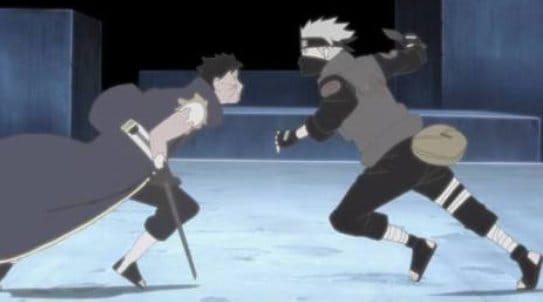A Battle Across Time: Obito Uchiha vs Kakashi Hatake
The once dedicated and companionable Uchiha had now shed who he once was as he stood before the man who once desired no companions but now values teamwork and family. The last time these two interacted, they both lost an eye—willingly and unwillingly.

There are many battles in anime that stand out and get tons of praise and recognition. Few have their own mark in history for the influential impact it had on anime as a genre. Goku versus Frieza is the blueprint of anime influence. The entire battle that took place on Planet Namek ran for 4 hours and 13 minutes. It takes about the same amount of time to drive from downtown Houston, Texas, to Shreveport, Louisiana. An entire road trip without stopping to fill up the gas tank. No filler (heh). But that's beside the point. All animated battles do not have to take as long to be considered memorable, like the Dragon Ball Z classic. The ascension of Goku to a higher level was the cherry on top to cement it as an exemplary model for those to aspire to and surpass.
However, let me not be hasty and bite my tongue and say that other battles would not be as impactful as the former in their uniqueness. Some clashes stand tall with pride, knowing what they bring to the table when it comes to an in-depth discussion. One in particular that stands firm in its glory comes from Naruto: Shippuden. A confrontation between two former comrades. One, a class clown from a reputable clan that has no talent, goes by the name of Obito Uchiha. The other is a talented prodigy who strongly believes there is an "I" in "Team": Kakashi Hatake. On paper, they do not appear to be compatible, and even more so on the same squad. Yet they improve one another just as iron sharpens iron. They take on each other's philosophy, to which they apply their essence. A class clown stands true to their abilities, while the other warms to the idea of teamwork. And yet, people still change in the most unsuspecting circumstances. Some become better versions of themselves, while others become the very essence of the thing they despise the most.

During the Third Shinobi World War, a young Obito put himself in harm's way to protect both his teammates from being crushed by a boulder while trying to escape from a collapsing cave. With the expectation that young Obito's life would soon cease to exist, Kakashi, who earlier lost his left in battle, receives Obito's left eye, the Sharingan, as a last-minute birthday present. A gift that even in death he would be his "eye" and keep watch of what the future will bring. Eighteen years later, during the Fourth Shinobi World War, these two unexpectedly face each other again while sharing the same set of eyes. Not only have they become highly skilled shinobi, but they also have an entirely new stance on life. The once dedicated and companionable Uchiha had now shed who he once was as he stood before the man who once desired no companions but now values teamwork and family. The last time these two interacted, they both lost an eye—willingly and unwillingly.
What makes two former teammates who instituted camaraderie during their final mission together end up with the resolve to kill each other years down the line? I often hear the question, "What is time?" when discussing life events. (And physics for that matter.) The fight between these two shinobi stresses that very argument. Understand that this is not the typical battle measuring strength or talent, for that matter. It extends past the surface level of amazing acrobatics and into the mental plane. It begins with a flashback no jutsu to an early sparring match. A young Obito and Kakashi face off against one another in front of their sensei, Minato Namikaze, and fellow teammate Rin Nohara. Minato signals the start of the fight, and that is where the spectacle begins. It snaps back to the present and begins from a bird's-eye view that pans around the two fighters 720 degrees as they engage in hand-to-hand combat before leveling out and transitioning back to the past. A viola stealthily enters somberly to match the sound of strikes being thrown. The occasional loud 'bam' after a successful blow of a poorly guarded defense. The somber score picks up in an expected dramatic fashion yet goes unnoticed by the viewer, as the intensity of the battle heats up like water boiling in a pot on a stove. The music acts on the viewer's subconscious, which drives the emotional dynamic of both fighters, based on prior knowledge of their connection to one another. The vibrations produced by the kunai knives clashing cause sparks to fly uncontrollably. The element of air being sliced after an assessed toss of a kunai for a brief momentary relief to follow up with a premeditated plan of attack. The surge of adrenaline that rises from the core of their souls is translated into a facial expression that can easily be identified as bloodlust. Constant acrobatic flips over each other to exploit an opening that is countered by reflex and muscle memory from experience. While the majority of viewers would be amazed at the art scheme and the fluidity of the taijutsu, underlining that is a contest of strategic mental gymnastics. Rather, it is a chess match between the body and mind. You know all the pieces on the board and what purpose each piece serves. You know the strategy your opponent will execute, and therefore you plan accordingly. All the while, you both are trying to inject an action that is not part of the known set of tactics. Ingredients to create a recipe for deception.

Several moments grasp my attention, and I can't help but replay them over and over again. The series of air kicks that Kakashi dishes out gives the illusion that gravity is irrelevant. Even the nifty trick shot with the back of his heel sent an airborne kunai across Obito's cheek, planting it into the ground. But the highlight for me is Obito's forced hand signal to Kakashi to perform the Fire Style: Fireball Jutsu. The animation of his lungs filling with air stirs the inner child within to perform the same gestures with necessity.
"I'm going to borrow this."
The moment Kakashi took his eyes off Obito with the forced hand sign was meant to be interpreted as a compliment of amazement and pure disbelief. In that instant, Obito had the upper hand in speed. Nevertheless, Kakashi’s answer is Earth-style: Mud Wall shows the capability humans have to push forward into the unknown even when all hope seems lost. The fireball strikes the mud wall like a raging inferno with such intensity that it disintegrates parts of the barrier as ash and smoke billow past while no harm has come to Hatake. A monumental testament to the strong will. As the debris settles from the collision of fire and earth, the sound of metal scraping the ground has the Copy Ninja questioning the next upcoming ploy.
Under the guise of the smoke mass from the earlier elemental collision, Kakashi senses a presence coming from his right. He turns.
Decoy
The kunai that was planted into the ground from the high kick with his heel that cut Obito’s face was now being returned as a deception tactic. And it proved effective by drawing Kakashi's attention away from the incoming threat on his left. By the time he realized that he had bit the bait, it was too late. A powerful kick to the Copy Ninja's neck left him discombobulated after being slammed against his mud wall by the force of impact. A sly smirk appears on Obito's face. Smugness? No. Complacency. A mannerism that defined his confidence in his ability. A trait he lacked as a genin. He rushes in for the finishing blow with a black receiver protruding from his right hand. Again, Kakashi counters him with a clone that bursts forth from under the ground with a shadow clone and grabs his arm, stopping the fatal blow. Their eyes locked as if they were inflicting their own will on each other.
"As to be expected" can be construed from the leering look Obito gives Kakashi. An aggravation rather than praise of his skill and reputation. A vexation that prods Obito's deception to a deeper level, in which he declares, “The real one is here!” From his left hand, a black receiver stems out. Anticipation and judgment of character are formulas that grant the ability to see into the future. In that moment, Obito did see the future. However, Kakashi could see further than him as he instantly altered the shadow clone to his signature technique, Lightning Blade. Obito is electrocuted and yells out in pain. Even with both the Rinnegan and the Sharingan, he was unable to anticipate Kakashi’s deceit. A kick to the chin parallels back to their childhood. Obito looks down, reminded of why he was jealous of him for his natural talent. Kakashi, holding nothing back, follows up with another kick that sends Obito soaring before he hits the ground rolling.
A young Kakashi points his kunai into the face of Obito, signifying the end of the battle. Minato instructs them to end by performing the unison sign (sportsmanship). The music subsides as silence settles in comfortably. But it kicks silence right out as Obito denies the inner child in himself, figuratively and literally, as its present and past enmesh as one. The former companions charge at each other for the final deciding blow. A final blow that doesn't reward anyone in the end. Because nobody wins when the stakes involve the loss of life.
